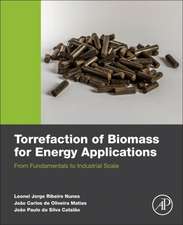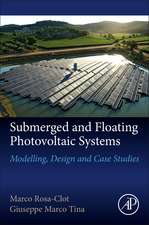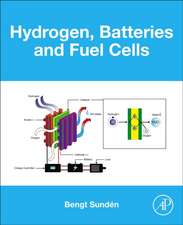Modeling Solid Oxide Fuel Cells: Methods, Procedures and Techniques: Fuel Cells and Hydrogen Energy
Editat de Roberto Bove, S. Ubertinien Limba Engleză Paperback – 21 noi 2014
| Toate formatele și edițiile | Preț | Express |
|---|---|---|
| Paperback (1) | 646.11 lei 6-8 săpt. | |
| SPRINGER NETHERLANDS – 21 noi 2014 | 646.11 lei 6-8 săpt. | |
| Mixed media product (1) | 655.60 lei 6-8 săpt. | |
| SPRINGER NETHERLANDS – 29 apr 2008 | 655.60 lei 6-8 săpt. |
Preț: 646.11 lei
Preț vechi: 760.13 lei
-15% Nou
Puncte Express: 969
Preț estimativ în valută:
123.63€ • 129.43$ • 102.30£
123.63€ • 129.43$ • 102.30£
Carte tipărită la comandă
Livrare economică 05-19 aprilie
Preluare comenzi: 021 569.72.76
Specificații
ISBN-13: 9789400796102
ISBN-10: 9400796102
Pagini: 412
Ilustrații: XIV, 397 p.
Dimensiuni: 155 x 235 x 22 mm
Greutate: 0.58 kg
Ediția:2008
Editura: SPRINGER NETHERLANDS
Colecția Springer
Seria Fuel Cells and Hydrogen Energy
Locul publicării:Dordrecht, Netherlands
ISBN-10: 9400796102
Pagini: 412
Ilustrații: XIV, 397 p.
Dimensiuni: 155 x 235 x 22 mm
Greutate: 0.58 kg
Ediția:2008
Editura: SPRINGER NETHERLANDS
Colecția Springer
Seria Fuel Cells and Hydrogen Energy
Locul publicării:Dordrecht, Netherlands
Public țintă
Professional/practitionerCuprins
Modeling Principles.- SOFC in Brief.- Thermodynamics of Fuel Cells.- Mathematical Models: A General Overview.- Single Cell, Stack and System Models.- CFD-Based Results for Planar and Micro-Tubular Single Cell Designs.- From a Single Cell to a Stack Modeling.- IP-SOFC Model.- Tubular Cells and Stacks.- Modeling of Combined SOFC and Turbine Power Systems.- Dynamic Modeling of Fuel Cells.- Integrated Numerical Modeling of SOFCs: Mechanical Properties and Stress Analyses.
Textul de pe ultima copertă
This book is intended to be a practical reference to all scientists and graduate students who are seeking to define a mathematical model for Solid Oxide Fuel Cell (SOFC) simulation.
At present, there is a strong interest from both industry and academia in SOFC modeling, but the resources are currently limited to technical papers, which usually fail to provide basic understanding of the phenomena taking place in an SOFC, as well as to describe the different approaches needed for different requirements.
This situation is in contrast with the present demand in SOFC modeling, coming from scientists, students and young researchers.
This work has three main objectives:
Firstly, to provide the necessary theory behind SOFC operation.
Secondly, to analyze different approaches for SOFC modeling.
Thirdly, to present the reader with all the necessary tools for defining his/her own model, according to his/her specific needs.
The volume is structured in two parts. Part one presents the basic theory, and the general equations describing SOFC operation phenomena. Part two deals with the application of the theory to practical examples, where different SOFC geometries, configurations (from single cells to hybrid systems), operating conditions (steady-state and dynamic), and different phenomena (e.g. performance, temperature and chemical species, and mechanical stress distribution) are analyzed in detail.
At present, there is a strong interest from both industry and academia in SOFC modeling, but the resources are currently limited to technical papers, which usually fail to provide basic understanding of the phenomena taking place in an SOFC, as well as to describe the different approaches needed for different requirements.
This situation is in contrast with the present demand in SOFC modeling, coming from scientists, students and young researchers.
This work has three main objectives:
Firstly, to provide the necessary theory behind SOFC operation.
Secondly, to analyze different approaches for SOFC modeling.
Thirdly, to present the reader with all the necessary tools for defining his/her own model, according to his/her specific needs.
The volume is structured in two parts. Part one presents the basic theory, and the general equations describing SOFC operation phenomena. Part two deals with the application of the theory to practical examples, where different SOFC geometries, configurations (from single cells to hybrid systems), operating conditions (steady-state and dynamic), and different phenomena (e.g. performance, temperature and chemical species, and mechanical stress distribution) are analyzed in detail.
Caracteristici
The book provides a comprehensive analysis of different approaches for modelling SOFC Theory is complemented with examples and the related data used in the implementation Researchers will find it as a starting point and a reference for defining their own models Mathematical models for single repeating units, single cells, stacks and systems, at steady-state and dynamic conditions are fully defined and analyzed.























